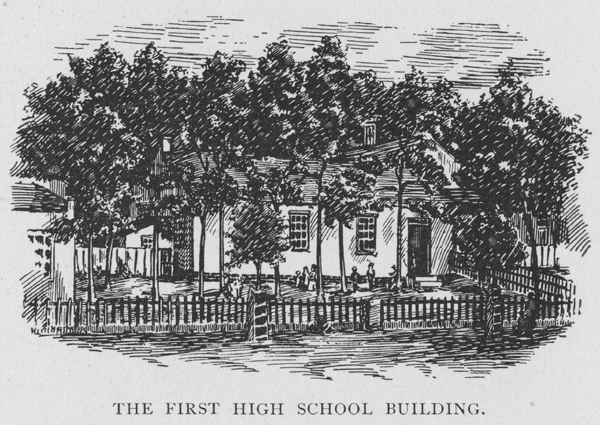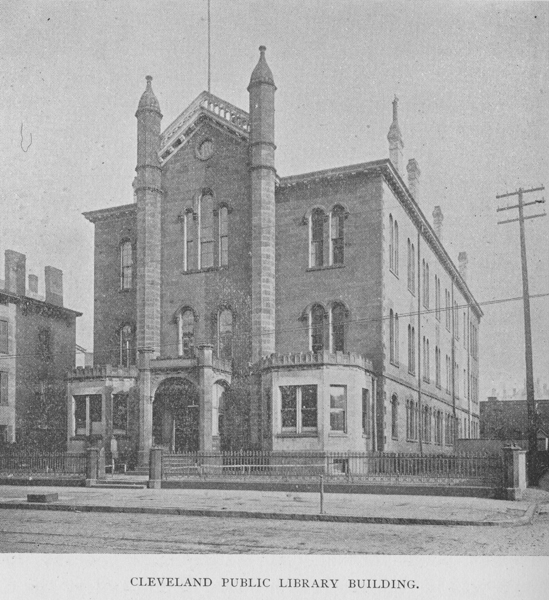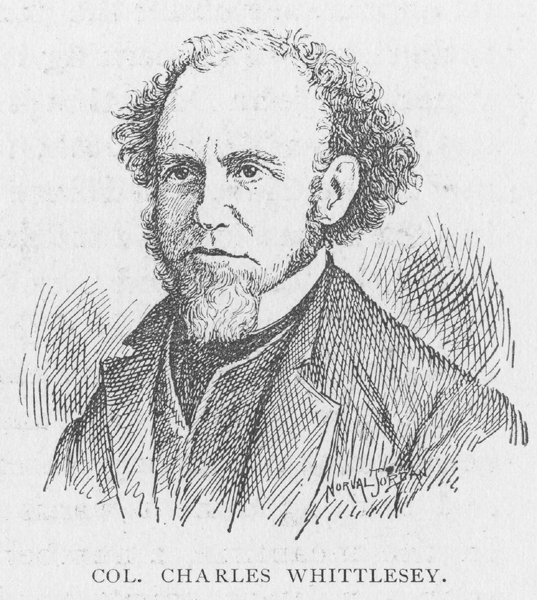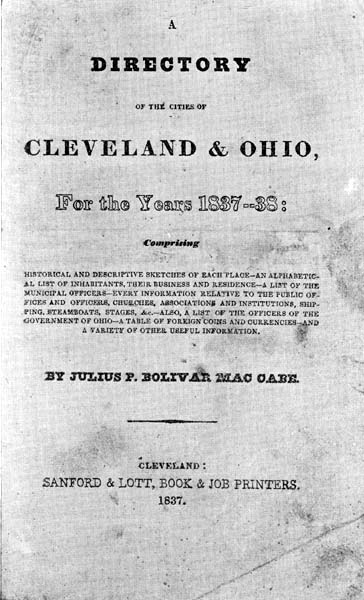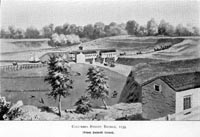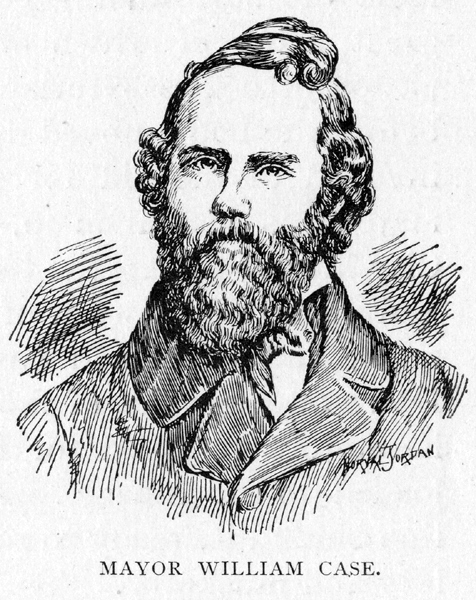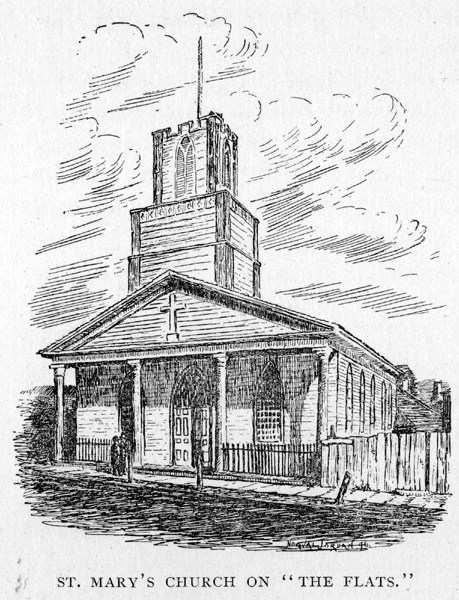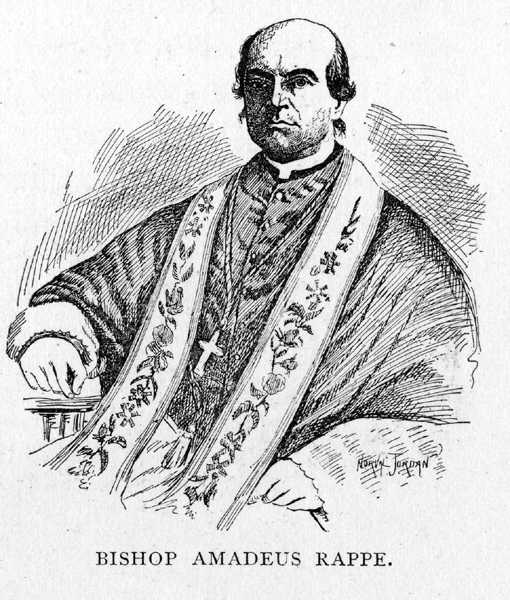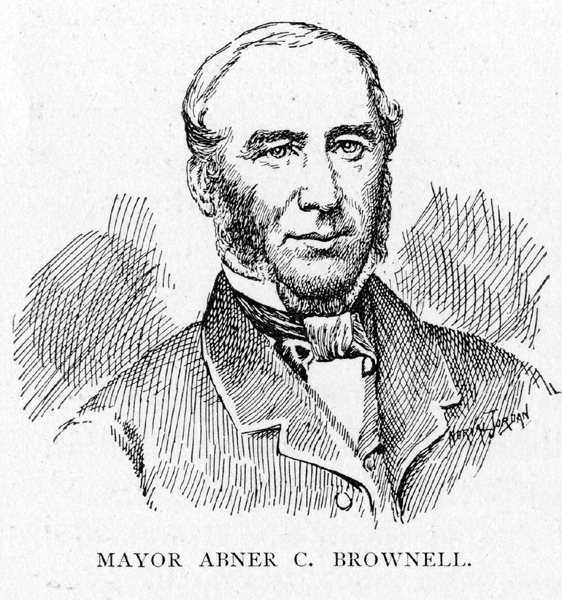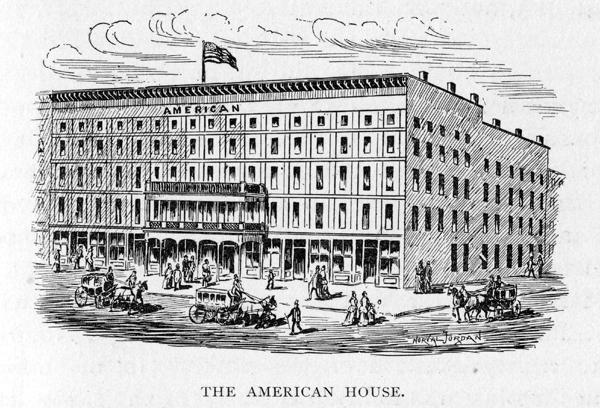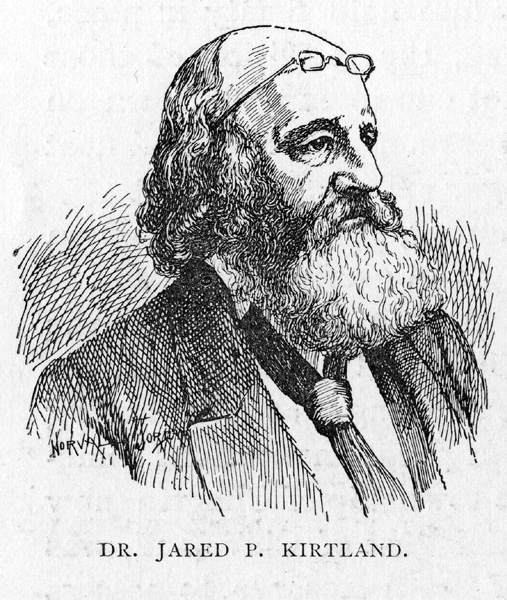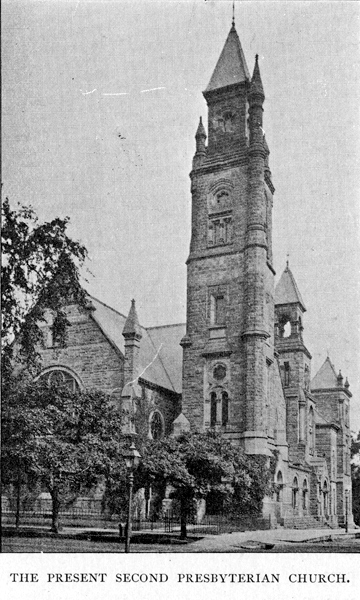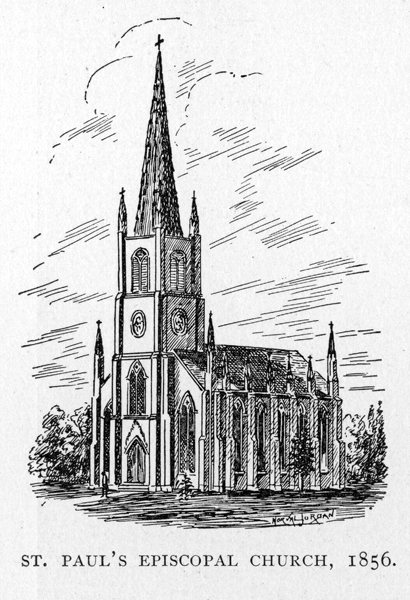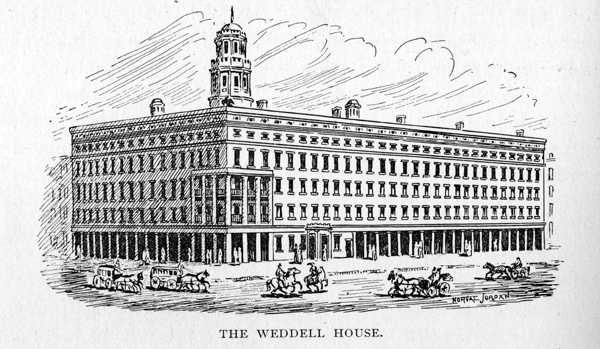|
CHAPTER XII MANY EVENTS OF A FRUITFUL PERIOD. This determined fight for the high school system, that was so successfully made by its friends, is of especial interest because the arguments that were made in opposition then have been heard with equal emphasis but less effect in these later days. The matter was taken into the newspapers, and upon the rostrum. A mass meeting was called in favor of the school, at which addresses were made by Dr. Fry, principal of the West St. Clair street grammar school, James A. Briggs, and Bushnell White. The school managers placed themselves upon the record with the declaration that it was their firm conviction that the system was "essential to the success of the public schools," and added: "It is the only way in which they can be made in truth what they are in name�common schools�common to all; good enough for the rich, and cheap enough for the poor�such schools as will meet the wants of all classes in the community." This was the deliberate opinion of Charles Bradburn, Truman P. Handy Samuel Starkweather, and William Day. Does not that striking sentence�"good enough for the rich, and cheap enough for the poor"�sum up the public school system of Cleveland in a word?174 The school was allowed to run along in its own way until the following winter, when a legislative enactment was secured from the general assembly by which the City Council was "authorized and required" to establish and maintain a high school department. That settled the question of legality, and an ordinance was passed as directed. The support given, however, was half-hearted, and for some time the appropriations for support were kept down to the lowest possible sum�about nine hundred dollars per year.
The average attendance during the first three years was about eighty. Two teachers, only, were employed up to 1852, when a third was secured. A lot for a high school building was purchased in 1851, and a cheap wooden building put up for temporary accommodation. In 1856, a stone structure was erected, and after many years� use for school purposes, became, at last, the headquarters for the Board of Education and the Public Library, in which useful service it still continues. It cost about twenty thousand dollars, and was dedicated on April 1st, 1856. As has been shown, the management of the early schools was in the hands of a board appointed by the City Council. This continued until 1858, when a change was made. After 1841, the secretary of the board was paid a small salary, and was called the acting manager, the executive and clerical work being left largely in his hands. Visiting committees were appointed from time to time, whose duties have been defined thus: "These committees are recommended by the board and appointed by the Council, but represent neither. They are the representatives of the people, appointed to examine the schools and to make known the results of the examination through their reports to the board. They are requested, also, to suggest such amendments, improvements, and changes, as they may deem essential to the success and prosperity of the schools."175
As the city grew, and the schools increased in size and importance, the need of increased facilities, and more direct management, was keenly felt. In response to this demand, Richard C. Parsons, in May, 1853, introduced an ordinance in the City Council, establishing the office of superintendent of instruction. It became a law in June, and in the same month Andrew Freese, principal of the high school, was appointed to the position, which he held until August, 1861, when L. M. Oviatt became his successor, and in two years was himself succeeded by Anson Smyth.
Municipal law-making and the founding of schools, were by no means the only measures by which these two newly-born cities of the Cuyahoga valley made use of their lately acquired legislative powers. Attention was paid to the condition of the lake front, which was a matter of great importance now that the lake marine was so rapidly growing. In 1837, an act was passed incorporating the Lake Shore Company, which had authority to take such steps as were necessary to protect the lake banks from the encroachments of the water, and as payment for their expenditures, permission was granted the company to build wharves and piers. Little, if anything, was done under this authority but at a later date the city employed Col. Charles Whittlesey, at considerable expense, to drive piles along certain portions of the lake front, which work was continued afterwards by the railroads for their own protection. Ohio City, not to be outdone, in 1837, procured an amendment to its charter, by which it was given authority to dig canals, slips, and basins, the cost of which was to be charged to the abutting property. Of this amendment, Judge Griswold, in the valuable document already quoted, has said: "By this act a large parcel of territory in the southwest part of that city was carried back into the township of Brooklyn.
That city proceeded under the act to construct a canal leading out of the old river bed, and paid for the same by this seductive, but ruinous method of taxation to defray the cost of public improvements. The scheme was a failure, but the dry bed of the canal has since been utilized for the laying railroad tracks. From want of means, being unable to enter upon the construction of railroads, the citizens of Cleveland contented themselves with procuring charters for the construction of plank roads leading out on all the principal highways from the city." It was, also, in 1837 that Cleveland began to have aspirations in a military direction, that set its bounds a little beyond the early militia, over which Major Carter and his associates held command, as we have already seen. The organization of the companies, that stood ready to defend their homes during the war of 1812, has been noted also. About 1825, a regularly formed military organization made it appearance under the name of the "Light Horse," but little is known concerning it, beyond the statement of the venerable John Doan that it "disbanded in the early thirties."176 On August 28th, 1837, a number of gentlemen met at the Cleveland House for the purpose of considering the formation of a military company, which was to be called the "Cleveland City Guards." "After a number of meetings," says Mr. Hodge in the paper referred to in note, "[Timothy] Ingraham, who had been selected for captain, was taken sick, and remained in poor health for several months, during which time drilling was suspended, and nothing done toward perfecting the organization. In the meantime, a number of other young men, imbued with a military spirit, decided to form a company independent of the one already started. A man by the name of Ross became the drill master, and afterwards was made captain. As the company started by Captain Ingraham and others had shown no life for several months, the new company could see no reason why it might not take the name of Guards, and so it did. The name �Guards� at this time was very popular, and the first military company in a city was sure to adopt it. The men under Captain Ingraham had decided that the color of their suits should be gray, but as there was not cloth enough to be had in the city of that color, of the same shade, it was evident the company must for some time delay its debut, and that the new company, which had been started by Captain Ross, would be the first to appear in public. In view of these facts, the men under Captain Ingraham decided on the 7th of June, 1838, that the name City Guards should be dropped, and thereafter the company should be called the Cleveland Greys. There was very little objection to this, since the name so well corresponded with the color of the uniforms. July 4th, following, the City Guards under Captain Ross turned out for parade. It was the first appearance of the company. Dressed in blue, with gold-colored trimmings, the men made a very showy appearance. At a Fourth of July banquet that evening, Mr. D. W. Cross proposed this sentiment: �The Cleveland City Guards, may their military spirit and enterprise be duly appreciated by our citizens.� Mr. Cross at the time was a member of the Greys, but he admired the spirit the Guards had shown." The first appearance of the long-since famous Greys upon the street in full uniform, was on September 6th, 1838, and the "Herald" spoke with the warmest praise of their "neat, tasty uniforms, glittering bayonets, precise military evolutions, and correct soldier-like bearing." A gun squad connected with the company was soon after formed. Mention is made of the Guards on parade as late as July 4th, 1843, and that is the last we hear of them. In June, 1845, the Greys turned over to the artillery squad, which had now become an artillery company, many equipments; and upon the disbandment of the parent company, which soon followed, many of its members went into the "Light Artillery," as it was called, and which was under command of Captain D. L. Wood. It was in this year (1847) that the German Guards made their first appearance, under the command of Captain Silberg, General A. S. Sanford succeeded to the command of the Greys in 1847; and in the Fourth of July procession of that year two new organizations appear upon the scene�the Yagers, under command of Captain A. Seywert, and the Hibernian Guards, under Captain P. A. McBarron. The mention of General A. S. Sanford in the above naturally leads to a work in which he was very much interested�Cleveland�s first city directory, published in 1837.177 The firm of Sanford & Lott were printers, bookbinders, stationers and publishers. The directory contained 1339 names, of which 275 were credited to Ohio City. It names four newspapers and eight church congregations as among the city�s possessions, and furnishes much other valuable information. The city hospital was situated in a plat of four acres on Clinton street, in the easterly part of the city, and was 70 by 35 feet in size, with two stories. There were four public markets; one theatre, the "Cleveland"; the rooms of the Cleveland Reading Room Association were open daily; while the chief manufacturing plants consisted of the following: Four iron foundries and steam-engine factories, three soap and candle factories, two breweries, one sash factory, two rope walks, one stoneware pottery, two carriage factories and two factories for the making of millstones. There were two banks, the Commercial Bank of Lake Erie, with a capital stock of $500,000, and the Bank of Cleveland, $300,000. The Cleveland City Temperance Society had a membership of 260; while one advertisement declares that "strangers visiting the city will find the Shakespeare saloon an agreeable retreat, and every attention paid to their comfort and convenience." The Cuyahoga Anti-Slavery Society was in existence, with Edward Wade as president; the Western Seaman�s Friend Society was presided over by Samuel Cowles; Mrs. L. C. Gaylord was president of the Cleveland Maternal Association; David Long president of the Cleveland Anti-Slavery Society; the Cleveland Harmonic Society had seven members; T. P. Handy was president of the Cleveland Vocal Society; the Cleveland Lyceum and the Cleveland Polemic Association were flourishing concerns, with John Barr and James S. Underhill as presidents, respectively; Charles Whittlesey was president of the Young Men�s Literary Association, and John M. Sterling of the Cleveland Reading Room Association. Announcement is made of a daily line of Ohio Canal packets, between Cleveland and Portsmouth, on the Ohio River. A boat left this city at four o�clock each afternoon, and reached the Ohio end in about eighty hours, if things went well. The Pioneer Fast Stage Line to Pittsburg was an established and popular institution. The stage ran to Wellsville, where a boat was taken to Pittsburg, making the trip occupy about thirty hours. At Pittsburg, connection was made with the Good Intent Fast Mail Stage Line for Philadelphia, New York, Baltimore, and Washington, over which line those from the Pioneer line had the preference. A brief study of some of the advertisements in this work may be entertaining and instructive. Richard Crook, of the Eagle Tavern on the corner of Water and St. Clair streets, returns his thanks for liberal patronage. The Cleveland Center House was located in the Cleveland Center Block, within a few rods of the steamboat and canal packet landings: It was designed to be one of the principal hotels in the western country: A picture of the building shows it to be three stories high, with six windows on each floor front. Books were sold at wholesale and retail by Henry E. Butler. Dr. Strickland, a dentist, manufactured "incorruptable teeth," and advertised that families might command his services by the year, or otherwise. William R. Richardson furnished warm or
Facing Page
shower baths at the Spring Cottage, Clinton Park, three-fourths of a mile from the court-house, near the Mineral Spring, a coach leaving every hour, to convey passengers to and from the park. Peter M. Weddell & Co., (the company being Dudley Baldwin and Peter P. Weddell) kept "constantly on hand, at the old stand, corner of Superior and Bank streets, No. 2 Washington block, so long and so favorably known to the public, a very extensive assortment of dry goods." There are many other announcements of a like character. During this somewhat long digression, we have left Ohio City alone in its new civic honors, and it is now time to note a series of stirring events taking place upon that side of the river. In April, 1837, James S. Clark and others laid out an allotment which embraced the greater part of Ohio City lying west and south of that of Barber & Sons, and called the same "Willeyville." "When this gentleman and his associates," says Judge Griswold, "had made the allotment of Cleveland Center, as it was called, they had laid Columbus street from the north line to the river. In this new plat, over the river, Columbus street was laid out through its center to connect with the Wooster and Medina Turnpike, as it was called, at the south line of the City of Ohio; the northern end of said street being exactly opposite the southern end of the Columbus street of the other plat. Mr. Clark also erected a large block at the northern end of Columbus street, and two large blocks on the opposite corners of Prospect street, where it intersects Ontario." The managers of the Buffalo Company had been equally active, in pushing and developing their interests upon their own side of the river. They constructed a large hotel on Main street, in the hope of attracting travelers to that portion of the city. Mr. Clark went a step further. In laying out the Willeyville tract, he had expended considerable money in grading the hill, and thus bringing Columbus street down to the river. He had constructed, also, a bridge across the river, in the expectation that travel and traffic from the south would come into Cleveland, by this route, and then be led up Michigan street to Ontario and Prospect streets, because of the easy grade. A highly laudatory account of the erection of this bridge, and a detailed description of the structure itself, may be found in the directory above referred to. It cost some fifteen thousand dollars; was "supported by a stone abutment on either shore and pieces of solid masonry erected in the center of the river. Between the piers, there is a draw sufficient to allow a vessel of forty-nine feet beam to pass through. The length is two hundred feet, and breadth, including the sidewalks, thirty-three feet, and the height of the piers, above the surface of the water, may be estimated at twenty-four feet. The whole, with the exception of the draw, is roofed and enclosed, presents an imposing appearance, and reflects much credit on the architect, Nathan Hunt." "This splendid bridge," adds the directory man, "was presented to the corporation of Cleveland by the owners, with the express stipulation that it should forever remain free for the accommodation of the public, although the Legislature had previously chartered it as a toll bridge." The erection of this bridge, incidentally, supplied Cleveland with one of the most exciting events of its early career,--the famous "Bridge War" between Cleveland and Ohio City, has been celebrated in song and story, and supplied the pioneer Clevelanders with a never-failing subject for anecdote and reminiscence. The residents across stream naturally objected to the new structure, on the ground that the people from Brooklyn, Elyria, and the country roundabout, would go over to Cleveland by the new route, instead of passing down into Ohio City, for their trading. This meant a direct loss, as each year brought hundreds of teams in, from the south and west, loaded with wheat, flour, corn, pork, etc., and many loads of good s were carried away in return. The claim was also set up, on technical grounds,178 that the bridge had not been located in exact conformity with law�a claim that the citizens of Cleveland vigorously denied. A new source of irritation for the West Side was opened, when Messrs. Willey and Clark put into operation a scheme that would operate more directly to the advantage of Cleveland. There was, down at Detroit street, a float bridge, one-half of which belonged to Cleveland and one-half to her rival. A resolution was adopted by the Cleveland Council directing the removal of the eastern, or Cleveland half of this structure. This act was performed one night while the Ohio Citizens lay dreaming future municipal greatness; and when the morning mists arose from over the valley of the Cuyahoga, they saw their direct communication gone, and realized that to reach the court-house and other points of interest in Cleveland, they would be compelled to travel southward, and make use of the hated Columbus street bridge.
The situation became critical. The war on the street corners and in the newspapers waxed intense. The war-cry "Two bridges or none!" became the slogan for the West Side. Indignation meetings were held, at which warlike speeches were made. A resolution was adopted by the Council of Ohio City that the new bridge was a public nuisance, and, as such, must be abated. The city marshal, backed by public opinion, swore in a number of deputies, and attempted to carry this order into effect. One night a heavy charge of powder was put under the Ohio City end of the bridge, and exploded. Some damage was done, but not as much as had been expected. The next move was the cutting of an immense ditch at each end of the bridge, thus making it useless for teams. The citizens of the West Side decided to take the matter into their own hands, and make sure that the order of their municipal legislature was carried out. A day of attack was set, and near one thousand men�some of them from the surrounding country�responded to the call, a great many of whom were armed. Rev. Dr. Pickans, pastor of a Presbyterian church, lent his presence, and before the body moved down upon the doomed structure, invoked divine aid for the undertaking. The line of march was then taken up, C. L. Russell, a well-known Ohio City lawyer taking the lead. An echo of this din of war had been heard across the river, and Cleveland was prepared to repel the attack. Down on their side of the stream stood an ancient cannon, heretofore reserved for Independence Day celebrations, loaded to the muzzle. A company of militia stood in line behind it, ready to rake the bridge with both artillery and musketry. When the army of advance reached the ditch at the south end of the bridge, they were met by the Mayor of Cleveland, who was prepared to advise peace and moderation. A volley of stones sent him back among his own forces. There was, at each end of the bridge, an "apron" that could be lowered or raised at will; that on the Ohio City side was let down, and in its shelter the West Siders went to work beyond the reach of the bullets of the troops. Axes and crowbars were plied lustily. Planks were ripped up, and thrown into the river. The militia made a charge, and a general fight ensued. Deacon House, of the Ohio City contingent, slipped a file into his picket, made his way across the bridge, and spiked the cannon before it could be brought into use. In the melee, a number of the fighters were injured. Some would have been killed had not the marshal of Cleveland and the sheriff of the county appeared upon the scene, compelled a cessation of hostilities, and taken possession of the disputed structure in the name of the law. A decree of the court was obtained against further interference, and at the same time, the marshal and a posse were placed on guard to prevent further depredation.179 The authority under which this official acted was set forth in a resolution offered in the Cleveland City Council on October 29th, by Edward Baldwin, and unanimously adopted. That measure declared that "during the night of the twenty-seventh instant a portion of the city bridge connecting this city with the City of Ohio was blown up; and the night of the twenty-eighth, the effectual application of powder to the southern abutment nearly destroyed the aforesaid bridge." The resolution further declared: "It is satisfactorily ascertained that the depredations aforesaid were committed by the inhabitants of Ohio City, during the commission of which depredations women and children were compelled to flee their beds in dead of night; a stone of the supposed weight of two hundred pounds was forced into a neighbor�s house of ten rods distance, and the lives of families and individuals jeopardized." The marshal was directed, therefore, to keep "an armed guard at said bridge, to protect the same from further injury;" while the street commissioner was instructed to repair the damage done, and the city attorney directed to take the necessary steps to bring the offenders to justice, and obtain payment of the damage. A second resolution was adopted on November 9th, directing the withdrawal of the guard. The civil courts finally settled all differences, and each city proceeded forward upon it own responsibility as before.180 The tide of apparent prosperity that had been, for several years, carrying all this section of the country toward supposed riches and a speedy development, was fictitious in a high degree, and when the day of settlement and reckoning came, Cleveland was compelled to bear its share of the burden�and it was one of severity that had to be carried for years. The whole west, and the country at large, felt the effect of these same memorable "hard times" of 1837. Speculation had been raging fiercely, values were set far in excess of actual worth, cities were springing up on paper in all directions, State and municipal credits were extended to railroad and canal enterprises far in excess of the needs of the country, or its ability to pay;. An immense number of banks had been chartered, as a result of the closing of the United States bank, the greater number of which possessed capital far short of the amount of currency put forth. Many of them, especially in the west and south, had no capital at all. The bills they issued were accepted everywhere, with hardly a thought of the possibility of their redemption in coin. Private credit could be had everywhere. An immense amount of business�on a paper basis�was being done, and everybody seemed to be getting rich. This flush and speculative era had an especially marked effect upon the two cities at the mouth of the Cuyahoga. The location, and the presence of the canal, marked Cleveland as a point to be especially moved by the sure, promise of a brilliant future, and speculation raged here with great vigor. No one seemed to see that with few manufactures, and a poorly developed agricultural section to draw upon, a great city could not be supported, even though faith and solid capital should unite in its creation; while a city built upon speculative enthusiasm and promises to pay could have small hope of permanent prosperity. Ventures of the wildest character were entered upon; there was a haste upon the part of all to be rich, and the whole country plunged ahead, putting forth unlimited promises to pay, and taking little heed as to the day or means of payment. The top-wave was touched in 1836, and in 1837 came the wreck. Bank after bank went down in the storm. Mercantile houses, companies, individuals, failed by the hundreds and thousands. The wild railroad, canal, and other schemes of public improvement, went to the wall. Ruin was upon every hand. The ties were left to rot upon the half-finished railroads; the half-dug canal filled up, and lay a stagnant pool; the ships stood unfinished upon the stocks; paper cities vanished into thin air; fortunes melted in a moment; municipalities were ruined, and State credits impaired; money that was good for one hundred cents upon the dollar yesterday, became but worthless rage to-day. In Cleveland, the great majority of the business houses failed. Land values sank to a low figure; a blow had been sent home to the little city that was felt for years, as we shall see, in various ways, in the records that follow.
There is little of especial moment to note in Cleveland, either in 1837 or 1838. There was practically no growth from 1836 to 1840; those who were here were repairing their shattered fortunes as best they could, and hoping for better times. The records show that only matters of routine occupied the attention of law-makers and executive officers. It was during these years that the first Catholic church of Cleveland came into existence. Rev. John Dillon, the first resident priest, had held service for a time in Shakespeare Hall, on Union lane, his congregation numbering but five families. He went to New York and collected a thousand dollars and more for the erection of a church her, but death ended his career before he could carry this purpose into execution. He was succeeded by Rev. P. O�Dwyer, who was soon enabled to commence the erection of the edifice known as St. Mary�s on the Flats. The church was completed, and mass celebrated for the first time toward the end of 1838. When Rev. Amadeus Rappe, first bishop of the diocese of Cleveland, took possession of his see in 1847, he made St. Mary�s his cathedral, and such it remained until the completion of the new cathedral, on Erie and Superior streets, in 1852.
By 1840, Cleveland began slowly to emerge from the disastrous effects of the days of inflation and subsequent ruin, and to turn a hopeful face toward the future. The census showed her population (in Cleveland township) to be about seven thousand.181 William A. Otis, in this year, established his iron works, the first of any importance in Cleveland, and thus gave an impetus to local manufacturing. The infant industry of coal mining had developed somewhat, and Cleveland began to be something of a market for the sale of that product. Of general business, we learn the following, quoted from a newspaper article of that year: "Business is slowly but gradually improving in this section. We begin to feel somewhat the influence of the cross-cut canal from Beaver to Akron, by the arrival of many kinds of good in the hardware line, that we used to be supplied with from New York and Boston, but which can now be procured from Pittsburgh at a saving of more than half in time, and twenty-five per cent. in cost."
Passing reference has been made, from time to time, to the business men who constituted the early mercantile force of Cleveland, and it seems a fitting place in the time of business revival, of which we are speaking, to give some details of these pioneer merchants. To trace the commercial growth of the city along its most natural lines, is to follow the career of these early merchants, and in so doing, that natural truth, the "survival of the fittest," is forced upon the attention. It took not only capital and a commercial aptitude to make headway against the drawbacks and difficulties of the early days, but courage, strength of mind and body, and a quiet patience that could wait for its reward. There were many men in whom such qualities could be found. There was John Blair, whose early venture here has been already described. Philo Scovill, who afterwards made a fortune in other lines, came to Cleveland as a merchant, bringing with him a stock of drugs and groceries. This line of trade did not suit him , and he soon worked out of it. Melancthon Barnett, father of General James Barnett, came to Cleveland in 1825, as a clerk for Mr. May, and soon found himself a partner in the firm of May & Barnett. In 1843, they would up their affairs as merchants, and took a hand in the wonderful land speculations of those days. The leather and dry-goods store of Joel Scranton, on the corner of Superior and Water streets, was for a long time one of the old landmarks. Orlando Cutter was for years one of the hard-working merchants of Cleveland. Peter M. Weddell, who had already shown great aptitude for business, came to Cleveland in 1820, and established himself here, taking a stand at once among the leading business men of the place. In 1825, he formed a partnership with Edmund Clade, from Buffalo, and retired from an active participation in trade. Three years later this connection was dissolved, and in 1831, he formed a new one with G. C. Woods and Dudley Baldwin, under the firm name of P. M. Weddell & Co. Four years later, Mr. Woods left the city, and Messrs. Weddell and Baldwin continued together until 1845. Mr. Baldwin had been a clerk for Mr. Weddell before the partnership was formed, and after it dissolution he gave some time to the closing up of the firm�s affairs, and then went into other lines of activity. Norman C. Baldwin�s first mercantile venture in Cleveland was as a member of the firm of Merwin & Baldwin, his partner being Noble H. Merwin, and their line produce. It was succeeded, in 1830, by Giddings, Baldwin & Co., which became one of the most important forwarding and commission houses on the lake. Richard Winslow was a strong addtion to the mercantile strength of Cleveland, when he decided on making this point his home, in 1830. He not only brought energy, but capital as well, and immediately opened a large grocery store on Superior street, opposite Union lane. He soon invested in the lake vessel business, and the boats he set afloat were seen on all the great lakes. S. H. Sheldon, in after years better known as a lumber man, opened his business life in this neighborhood by keeping a drug store on Detroit street, in what was than Ohio City. He sold out in 1842, but was afterward for a short time in the grocery line. Alexander Sackett, who had received a fine mercantile training in New York City, in 1835, opened a wholesale and retail dry-goods store in Mr. Weddell�s block on Superior street. He remained in that line until 1854, when he went into commercial business on the river. Charles Bradburn commenced his long and honorable career in Cleveland in 1836, when he opened a wholesale and retail grocery store on Superior street, next to the old city buildings. The next year he enlarged his establishment, and in 1840, moved to his new warehouse at the foot of St. Clair street, abandoning the retail branch. In 1854, he again moved, to numbers 58 and 60 River street, where he remained for a number of years. He was one of the most useful citizens Cleveland ever possessed, and a foremost spirit in all educational matters. About 1835, Samuel Raymond and Henry W. and Marvin Clark opened a dry-good store on the corner of Superior street and the Public Square, where the Rouse Block now stands. They occupied a little wooden building, and the location was about as far east as business then dare venture. Richard T. Lyon arrived here in 1823, and in 1838 became a clerk in the forwarding house of Griffith, Standart & Co., continuing there until 1841, when he formed a partnership with J. L. Hewitt, and carried on a forwarding the commission business on River street, under the firm name of Hewitt & Lyon. Thomas A. Walton was one of the well-known commission merchants, opening a business on the river. George Worthington�s hardware store was opened in Cleveland in 1834, on the corner of Superior street and Union lane; three years later it was removed to the corner of Water and Superior streets, on the site of the National Bank Building of to-day, and there it remained for nearly thirty years. N. E. Crittenden came here, in 1826, and opened the first jewelry store Cleveland possessed. E. P. Morgan�s first venture was made here in 1841. Robert Hanna; wholesale grocery and forwarding establishment was opened here, in 1852. In 1845, S. F. Lester became a member of the old and well-known firm of Hubby, Hughes *& Co., and when that partnership was dissolved in 1858, it was succeeded by the firm of Hughes & Lester, which continued until 1862. The connection of Hiram Garretson with the business circles of Cleveland commenced in 1852. A. G. Colwell came in the same year; William Edwards in the same year; E. I. Baldwin in 1853, and Grove N. Abbey in 1858. The chief topic of general interest in Cleveland, during 1840, was of a political nature, the little city, like its neighbors everywhere, entering with enthusiasm into the famous "Log-Cabin" and "Hard-Cider" presidential campaign of that year. General Harrison was warmly supported upon the Reserve, which was a Whig stronghold, and his followers entered into the fight with an enthusiasm that showed itself in many ways, and when the election resulted in his favor, no city received the news with greater joy than Cleveland. When the campaign was well under way, it was decided that a typical "cabin" should be erected upon each side of the river. "The one on the west side, then Ohio City," writes one182 who has made of these mid-century days an interested study, "was built first, and on the 18th of March was dedicated. The evening of the dedication the Whigs of the east side met at the American House, and headed by the Cleveland Grays, marched across to the cabin, which was built on the corner of Detroit and Pearl streets. It was constructed entirely of logs, and had an oak roof. Within, on the walls, hung strips of dried pumpkin and strings of dried peppers; a rifle rested on hooks, while a pouch and powder horn hung near by. A split broom stood in one corner, and in another was seen a barrel of cider. At the meeting, about five hundred people were present. A number of speeches were made by local orators, after which a glee club sang a campaign song, one verse of which was: "The bee for raising the log-cabin on the east side of the river�Cleveland�took place on March 30th, and the work was commenced at nine o�clock in the morning. The day was rainy, but a barrel of hard cider which had been contributed for the occasion kept up the spirits of the men, and the work went on with a will. The cabin was erected on a vacant lot on Superior street, just east of the American House, about where the �Leader� building now stands. The towns around Cleveland each contributed a quantity of logs for the building. Newburg brought in a tree very straight, and one hundred and five feet long. A pole fastened to it had a flag at the top, on which was inscribed: �Liberty.� On one of the logs brought in might have been seen this inscription: "On another was a keg marked �Hard Cider.� The cabin was 35 by 50 feet in dimensions, and, it was claimed, would hold seven hundred people. On each side of the entrance was a flagstaff. Opposite the door, on the inside, was large stump, upon which the speakers addressing the meeting were expected to stand. A small black bear had been secured, and fastened with a chain to a large cross-beam overhead. There was rough drawing, representing an eagle holding in his talons a writhing fox�supposed to be Van Buren. Tin cups, spades, shovels, and the inevitable barrel of hard cider were in the cabin. "The dedication occurred on April 3d, and the crowd present was very large, and the enthusiasm great. There were a number of speeches , and several campaign songs enlivened the occasion. The following is a verse of the song sung at the close: General Harrison paid a visit to Cleveland, on June 13th of this campaign year, 1840. He came by way of the lake, on the steamer "Sandusky," and was escorted by the Grays to the American House, where he received the citizens, and made an extended speech from the hotel balcony. He left the city by canal packet, for Akron, accompanied by a number of friends. Two years later, the city also was honored by a visit from General Harrison�s opponent in this historic campaign, Ex-President Martin Van Buren, who reached here on July 12th, 1842, and was received with may marks of honor. He likewise addressed the people from that famous old balcony of the American House.
In the days we now have under consideration, there occurred an incident of direct local interest, and one that illustrated somewhat the attitude of the people of northern Ohio, at that period, toward the important question of slavery. As Cleveland was the principal port upon the lake shore in Ohio, and offered unusual facilities for the transportation of runaway slaves from Kentucky and Virginia across to Canada, it became a natural resort for many who were fleeing from their masters. Under the laws of the country, and somewhat in obedience to public opinion, the escaping slaves when arrested here would be turned over to those who claimed them, with hardly a question, and returned to bondage. In 1841, this careless and heartless indifference to the rights of such as might be unjustly apprehended, received a severe shock that changed the order of things. Three slaves, who were supposed to have escaped from New Orleans, were found in Buffalo, kidnapped by those who claimed them, brought to Cleveland, and placed in jail, where they were held under the laws of the United States. An application to see them was made by John A. Foot and Edward Wade, two of Cleveland�s leading Abolitionists, which was refused. An application of the same tenor was made by Thomas Bolton, who was not an Abolitionist, and was immediately granted. Mr. Bolton held an interview with the negroes, and decided that he would defend them. He did so, in the face of violent public opinion and even threats, and with great ability and courage, showed up the infamous course of kidnapping that had been pursued, and as a result procured the prisoners their discharge. The kidnappers, thereafter, made Cleveland the scene of their operations less frequently than before. A Masonic organization was among the new ventures of 1841. The charter of Cleveland City Lodge, No. 15, F. and A. M., was granted on September 21st of that year. Its first meeting was held on the 28th of the same month, when the following officers were elected: Clifford Belden, W. M.; Andrew White, S. W.; Willard Crawford, J. W.; Edmund Clark, treasurer; Erastus Smith, secretary. Among those who held the office of Worshipful Master in the early days of the lodge may be mentioned Timothy Ingraham, W. T. Goodwin, H. H. Dodge, A. D. Bigelow, S. E. Adams, E. R. Benton, Peter Caul, etc. The other Masonic organizations that came into being at a little later date, may be briefly mentioned: Iris Lodge, No. 229, was organized on October 22nd, 1852. The first officers were A. D. Bigelow, W. M.; W. H. Beaumont, S. W.; Robert Reiley, J. W. Bigelow Lodge, No. 243, was organized on October 20th, 1853, but was not granted a charter until October 17th, 1854. The first officers were: Gaston G. Allen, W. M.; Samuel W. Odell, S. W.; Alonzo Eldridge, J. W.; C. C. Stevens, S. D.; Stephen Buhrer, J. D.; H. L. Whitman, treasurer; A. H. Dubrey, secretary; L. W. Woolenneber, tyler. Among the organizations of Odd Fellows in Cleveland, in the earlier days, were Cleveland Lodge, organized in 1842; Erie Lodge, in 1844; Phoenix Lodge, 1854; Cataract Lodge, 1855. One of the chief events in Cleveland in 1842, was the first real attempt at paving. This was on Superior street, between the Public Square and the river, and also on River street. The plan pursued was somewhat primitive in character; the "paving" consisted of the laying down of heavy planking crosswise of the street. These planks were of use when new and while held firmly in place, but when worn out or loosened, the condition of those who traveled over them was not one to envy. Down on River street, the floods would sometimes rise, and float the paving off into the Cuyahoga. The year 1843 saw the beginning, in Cleveland, of an institution that has had a long and useful career, and is still counted one of the great educational features of the middle west. This was the Cleveland Medical College. Its origin is exceedingly interesting, as illustrating through what minor causes even great institutions sometimes come into existence. The township of Chagrin (now Willoughby), some twenty miles east of Cleveland, was one of the first town, on the Western Reserve, to possess a circulating library. The books were well selected, and out of the study and literary interest they aroused, there grew a flourishing lyceum and debating society. Lectures on historical and scientific questions were given, and the current questions of the day discussed. Out of this, a somewhat ambitious project, "The Willoughby University of Lake Erie," was born. Dr. George W. Card, Judge N, Allen, J. Lapham, Samuel Wilson, and others, were among its founders. It possessed a regular faculty, a board of trustees, president, secretary and treasurer. The medical faculty was constituted as follows: H. A. Ackley, M.D., professor of anatomy; Amasa Trowbridge, professor of surgery, Daniel L. M. Piexotto, M.D., professor of theory and practice of medicine; J. Lang Cassells, M.D., professor of chemistry; William M. Smith, M.D., professor of Materia Medica and botany. Some of these instructors were known favorably already, and have left since a deep impress upon the medical history of the west. In 1835-6, this University possessed twenty-three students; five were graduated with the title of M.D., in the year last named. A three-story brick building was erected for the use of the institution. It was the hope of the founders to build up a great medical college in Willoughby, but after a year or so of struggle it was seen necessary to move it to a larger place, and Cleveland was naturally the choice of the majority.
It was in the fall of 1843 that this decision was made. Drs. John Delamater, Jared P. Kirtland, John L. Cassells, and Noah Worcester, who were then members of the faculty, favored Cleveland, while Dr. Starling�s choice was Columbus, and as he owned a controlling interest, he carried the day, went to the city named, and founded the Starling Medical College. The other physicians went to Cleveland, and as they did not wish to wait for charter, the only legal process of incorporation, they applied to the Western Reserve College (afterwards Western Reserve University), at Hudson, for organization as the medical department thereof. The privilege was granted, and in that way the Cleveland Medical College came into being as a department of the older organization. A building was erected on the corner of St. Clair and Erie streets.183 The first faculty consisted of John Delamater, Jared P. Kirtland, Horace A. Ackley, J. L. Cassells, Noah Worcester, Samuel St. John, and Jacob J. Delamater, all physicians. The institution started immediately upon its long, honorable, and prosperous career.
Two of the older church societies of Cleveland were also organized in 1843. The United Presbyterian Church began with eleven members, on November 5th, in the Hancock Block, on the corner of Superior and Seneca streets. The first ruling elders chosen were I. Campbell, J. Dodds, and D. Pollock. In two or three years a church building was erected, on the southwest corner of Michigan and Seneca streets; while, in 1853, a larger and more commodious house of worship was erected on Erie street, near Huron street. The Euclid Avenue Congregational Church was organized on November 30th, 1843, by Rev. Dr. S.. C. Aiken and Rev. S. C. Cady, with a membership of nineteen. The name first chosen was that of "The First Presbyterian Church of East Cleveland," but changed to Congregational, in 1852, because of the attitude of the Presbyterian Church toward slavery. The first services were held in a building, known as the "old stone schoolhouse," between Republic and Doan streets, near Euclid avenue. Various other places of gathering were used until 1849, when a new building on the corner of Euclid avenue and Doan street was dedicated, and in that the society found a permanent home.
On June 12th, 1844, the Second Presbyterian Church of Cleveland was organized. The membership roll contained fifty-eight names, fifty-three of which were of former members of the First Presbyterian Church. The first meetings were held in a building on Rockwell street, which was used until a church edifice was erected on Superior street, east of the Public Square, and the basement first occupied in 1851. The first pastor of the church was Rev. Sherman B. Canfield, who officiated from 1844 to 1854, and the first officers were as follows: Elders, David Long, Henry Sexton, Jeremiah Holt, Eli P. Morgan, Jesse F. Taintor and Samuel H. Mather; Deacons, William A. Otis, T. P. Handy, and S. H. Fox. In 1876, the church building was consumed by fire; and an elegant new structure, on the corner of Prospect street and Sterling avenue, was completed and dedicated in 1878. Indeed, this period seems to have been quite prolific in the way of churches and church-building. Trinity Church had grown to such proportions that relief of some character was demanded, and on July 9th, 1845, the parish of Grace Church was organized as an answer to this demand. A lot was purchased at the corner of Erie and Huron streets, on which a substantial brick structure was erected. The first rector was Rev. Alexander Varian, who officiated from 1846 to 1849. St. Paul�s Episcopal Church also was organized on October 26th, 1846, with a membership of forty-five. The development of these days, however, was not altogether upon the religious side of the life of Cleveland. Literary and material things were receiving their due share of attention. The Young Men�s Literary Association was one of the events of 1845. The germ of this idea had been one of rather slow growth. As far back as 1811 some seventeen Clevelanders had associated themselves together for the establishment of a library, but the war of 1812 and the subsequent hard times intervened, and nothing was accomplished. In 1824, the Cleveland Forum, devoted principally to public debates, came into being, but after a few years of uncertain life it went into the limbo of discarded things. In 1833, a lyceum was formed with something of the same purpose, and in 1835 a reading-room was established through the generous contributions of citizens. In 1836, the Young Men�s Literary Association was organized, which also set out to form a library, but it was dissolved in 1843. The organization that was formed in 1845 under the same name achieved a more permanent success. In 1848, it was incorporated under the name of the Cleveland Library Association, with two hundred shares of stock at ten dollars each. A course of lectures was maintained for a number of years, but the main purpose in view was the accumulation of a library. A small room on Superior street was occupied for several yeas, then one in the "Herald" building; subsequently one at No. 221 Superior street, in 1856; and finally, in 1862, the Case Building. Here it received a perpetual lease of the rooms from the heirs of William Case, who had been a devoted friend of the Association. In 1870, the charter was so changed that the control was placed in the hands of five directors, elected for life. The first board consisted of Samuel Williamson, James Barnett, H. M. Chapin, William Bingham, and B. A. Stanard. The revenues were greatly enlarged by the gift of twenty-five thousand dollars from Leonard Case [Sr.], who, in 1876, followed this by the munificent donation of Case Block, which lifted the Association not only beyond any question of want, but placed the Case Library among the great libraries and literary institutions of the west.
Several enterprises, of a direct material benefit, also were noted as evidences of the returning prosperity that set in about 1845-6. The erection of the Weddelll House, on the corner of Superior and Bank streets, was one of these. It immediately took rank as one of the leading hotels of the west. On February 6th, 1846, the Cleveland Gas Light & Coke Company was organized, which indicated that the city had begun to figure upon metropolitan ways in real earnest. Nothing was done under this authority, however, until 1848, when the control of matters passed into the hands of Moses G. Younglove, through whose efforts works were constructed, the laying of pipes commenced, and the citizens permitted to enjoy the luxury of gas. PREVIOUS CHAPTER | TABLE OF CONTENTS | NEXT CHAPTER
|
